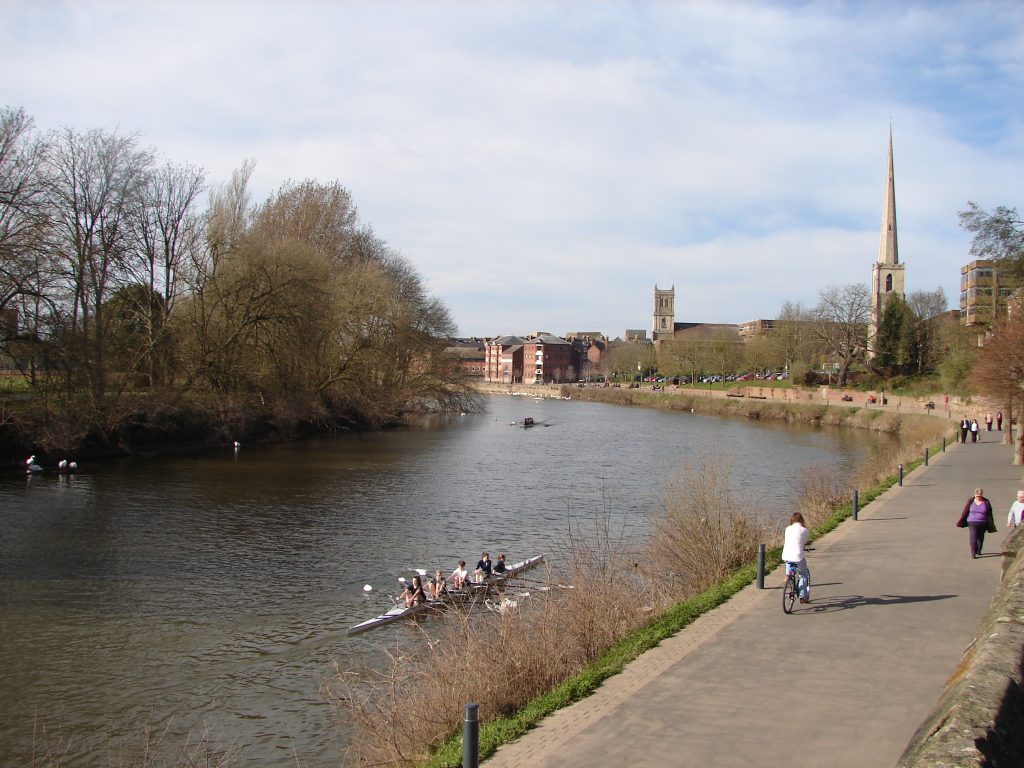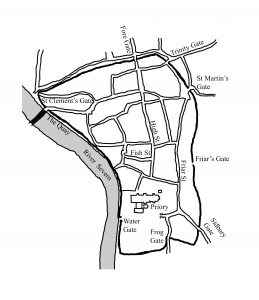 King Richard’s Sword, the sixth book in my Lady Apollonia West Country Mysteries, is set in the city of Worcester in the years 1399-1400. Worcester is located on the east side of the River Severn midway between Gloucester to the south and Shrewsbury to the north. These were principal medieval towns that grew at places where the river could be forded, especially at low tide. Begun as Roman towns, they had each provided access to Wales long before the Roman period. Worcester grew at a location on the river which could readily be defended.
King Richard’s Sword, the sixth book in my Lady Apollonia West Country Mysteries, is set in the city of Worcester in the years 1399-1400. Worcester is located on the east side of the River Severn midway between Gloucester to the south and Shrewsbury to the north. These were principal medieval towns that grew at places where the river could be forded, especially at low tide. Begun as Roman towns, they had each provided access to Wales long before the Roman period. Worcester grew at a location on the river which could readily be defended.
The name of Worcester suggests that the Romans occupied this place, but very little is known about the Roman town beyond its existence. The Roman walls probably enclosed a smaller area than did the later medieval walls, parts of which remain today. Roman coins from the 1st to the 4th centuries have been recovered. Enough fragments from the Roman period existed at the time of the Norman Conquest to recognise the site as a “chester” or Roman castre.
The Romans themselves may have called this place Vertis. Its name then evolved over the centuries from Uueogorna in the 7th century to Weogorna ceastre (or Fort of the Weogorna) by the 9th. The Weogorna were the people of the winding river. The picture at the top shows a bend which the River Severn makes at Worcester. The city name became Wirccester in the 11th and 12th, centuries, Wigornia from the 12th to 17th, and finally Worcester.
Christian churches in Worcester have been important for more than thirteen centuries. In the later 7th century, a church dedicated to Saint Peter was built and soon became the seat of a bishop. This has been the cathedra of a bishop ever since. I will write about the history of Worcester Cathedral in my next post.
The defences of Worcester were bolstered in the late 9th century, a period when the country was threatened by the Danes. It was also a time when Worcester achieved some status as a borough, complete with a borough court. The market of the town was important and provided a source of revenue for the build-up of its defences which influenced the location of the walls built in the medieval period.
The map which is pictured below shows medieval Worcester and its city wall and gates. Sidbury Gate and Frog Gate at the bottom play their role in my story. Both Lady Apollonia, my heroine, and Bryan Landow, the pardoner, are mentioned in the story as passing through the Fore Gate at the top of the picture. Although it is not stated explicitly, there are instances in the story when various characters passed through Saint Clement’s Gate on the upper left of the map because they crossed the river.
 Worcester often endured turbulent times. There was a rebellion in 1041 in reaction to the heavy taxes imposed by the Danish king. Within three years of the Norman Conquest, a motte and bailey castle was built on the southwest corner of the town. The 12th century saw four major fires consuming Worcester. On 19 June 1113, the town including its cathedral and castle were destroyed in a major fire. There were several local battles in the civil war between King Stephen and Empress Matilda. One of these resulted in a major fire in November 1131. Eight years later, a part of the city was burned when it was taken by a garrison from Gloucester. Finally, nearly the whole town was destroyed by fire in 1189.
Worcester often endured turbulent times. There was a rebellion in 1041 in reaction to the heavy taxes imposed by the Danish king. Within three years of the Norman Conquest, a motte and bailey castle was built on the southwest corner of the town. The 12th century saw four major fires consuming Worcester. On 19 June 1113, the town including its cathedral and castle were destroyed in a major fire. There were several local battles in the civil war between King Stephen and Empress Matilda. One of these resulted in a major fire in November 1131. Eight years later, a part of the city was burned when it was taken by a garrison from Gloucester. Finally, nearly the whole town was destroyed by fire in 1189.
Worcester was granted it first charter in in 1227 by King Henry III. Among its provisions, the charter granted the town a merchant gild or guild. It also provided that two local bailiffs would have precedence within the town over the sheriff of the County of Worcestershire. The gildhall became the local court of justice. Some Jews played a role in 12th century Worcester, especially as usurers, but by the end of the next century, Jews had been banned from England. Thus, others emerge as usurers and money lenders. They play a role in my story which is set at the end of the 14th century.
Worcester grew in prosperity in the 14th century despite the Black Death which reduced the population in 1348-49. The town’s population was around 2,600 people in 1377. It was important as a distribution centre for the western Midlands because of its bridge crossing the River Severn on the route to Wales. The manufacture of cloth became an important local industry, and continued well beyond the period of my book.
For more on the history of Worcester, click on
http://www.british-history.ac.uk/vch/worcs/vol4/pp376-390 or on
https://en.wikipedia.org/wiki/Worcester#History